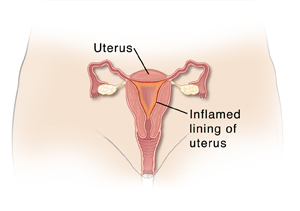You have endometritis. This means the lining of the uterus is inflamed. It's usually caused by an infection.
Common symptoms of endometritis are:
-
Fever.
-
Feeling ill.
-
Pain in the lower belly (abdomen).
-
Abnormal bleeding from the vagina.
-
Bad-smelling fluid from the vagina.
-
Pain when urinating.
-
Pain during sex.
-
Headache.
-
Fatigue.
-
Loss of appetite.
Endometritis can be caused by:
-
Vaginal delivery or C-section.
-
Long labor.
-
Miscarriage.
-
Abortion.
-
Tissue from the placenta that stays in the uterus after delivery.
-
Vaginal infection.
In some cases, an infection called pelvic inflammatory disease (PID) also happens. This affects the ovaries and fallopian tubes. If not treated, PID may lead to infertility. It can also lead to full-body infection (sepsis).
Home care
You may be given antibiotics to take for the infection. Your symptoms should get better within 2 to 3 days of starting the antibiotics. Take the antibiotics until they are used up. It’s important to finish the antibiotics even if you feel better. This is to make sure the infection has cleared up.
General care
You can take acetaminophen or ibuprofen for pain, unless you were given a different pain medicine to use. If you have chronic liver or kidney disease, talk with your health care provider before using these medicines. Also talk with your provider if you’ve had a stomach ulcer or digestive bleeding or are taking blood thinner medicine.
-
Plan to rest at home for the rest of the day.
-
Until you have taken all the antibiotics and your symptoms are gone:
-
Don’t have sex until your provider says it's okay.
-
Don’t put anything into your vagina, including tampons.
-
Don’t douche. Douching is generally not recommended at any time.
-
Don’t take a tub bath, use a hot tub, or swim. It’s fine to shower.
-
Follow-up care
Follow up with your health care provider, or as advised. You may need to have a procedure to clear tissue out of the uterus. This is called dilation and curettage (D&C). Your provider can tell you more about this.
Call 911
Call
-
Severe pain and very heavy bleeding
-
Severe lightheadedness, passing out, or fainting
-
Rapid heart rate
-
Trouble breathing
-
Confusion or difficulty waking up
When to get medical advice
Call your health care provider right away if any of these occur:
-
Fever of 100.4°F (38°C) or higher, or as directed by your provider
-
Symptoms get worse
-
You have new symptoms
-
Nausea or vomiting
-
Your symptoms don’t improve within 3 days of starting treatment
Featured in


